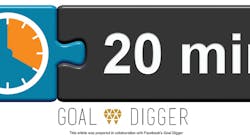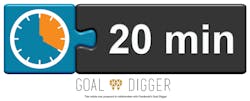How a 20-20-20 system can work for both the patient and hygienist
Connie Simmons, RDH, BSDH
I envision that as soon as some of you read the headline of this article there was a loud chorus of “no!” with many of you shaking your heads. At least that’s the response I usually receive when I discuss assisted hygiene in a busy practice. I will be the first to admit that if I had been asked this question nearly four years ago, I would have had the same reaction. Of course, if we’re just talking about an assistant helping us with our daily appointments, and we’re still given the full appointment time, most of us would accept the help. But that isn’t the assisted hygiene I’m talking about.
For the first 25 years of my dental hygiene career, I worked only in the private practice setting, and I usually had an hour for each adult patient. Having lived in multiple states and holding seven state licenses due to moving with my active duty Army husband, I’ve had the opportunity to work in a multitude of practice settings. Although most were general practices, I’ve worked in perio and pedo as well as spent significant time working through temporary services.
A big change
When we moved to northern Virginia nearly four years ago, the hygiene world as I knew it ceased to exist. Gone was the 8 to 5 Monday through Thursday schedule and half days on Fridays. Gone were the one-hour appointment times. And for me, also gone were the paper charts and nondigital radiographs, which were all I had been exposed to until then.
Wow! My world got complicated in a hurry! Don’t get me wrong, I knew that this was going to happen and I had prepared for it mentally, or so I thought. So, there I was on my first day at a temp placement job. I wanted to get my feet wet in the local dental scene before looking for a full-time position. Luckily, a dental assistant about my age quickly showed me how to expose digital radiographs and navigate the computer, and I was off and running! Fortunately, I am a quick hands-on learner and I was competent with both in a few days. It was tricky working as a temp and requiring adaptation to many different software programs for radiographs and charting, but I persevered and hopefully they couldn’t tell I was so green.
Fast forward a few months into temping and I was placed in the office where I’ve been working for about three years. I had gone on some working interviews but never really felt like any offices were a good match until this office. I found myself amid 12 females and one male doctor who all seemed like they genuinely liked to be around one another. I also found myself looking at two columns of hygiene for each hygienist with one-hour appointments staggered on the half hour. I had my own assistant and I easily fell into place as their “normal” temp hygienist on their busiest afternoons, evenings, and Saturdays. After a few months, I was asked to come on full-time.
Even though the office had been open only about one year, it was in such a populated area that practice growth was booming and we were able to keep four columns of hygiene booked and even added a fifth single column hygienist on busier days and times.
As a full-time hygienist, I was able to start making requests to implement procedural and protocol changes in the hygiene department. It took about six months or so to work through the changes, but we eventually got to a schedule that was physically possible for the hygiene team, and more importantly, most beneficial to the patients. Some of the changes included no staggered appointments next to periodontal or gingivitis therapy (because they require one-hour dedicated hygiene time), and new patients were not to be staggered because we’re all aware of how much time new patients can take.
With five columns of hygiene on most days, two columns of restorative, and one column for dental assistant II (DA II) to practice (in Virginia DA IIs can take final impressions, deliver and adjust removable prosthetics, seat and adjust crown and bridge, and restore teeth with composite or amalgam), we are a very busy practice. It takes an enormous amount of dedication and teamwork, but I’d say we’ve done an excellent job of making the office run like a well-oiled machine. Everyone knows their jobs and how to apply their skills so that the office and patients all benefit.
20-20-20 assisted hygiene
We base our appointments on the 20-20-20 appointment, which is common with practice management companies. The first 20 minutes is dedicated to the hygiene assistant, who seats the patient, exposes radiographs, takes blood pressure, reviews medical history, and completes initial plaque removal (polishing) for Type 1 patients. They also incorporate initial oral hygiene instructions and discuss the patient’s dental concerns and how to address them. If time permits, they also take intraoral camera images.
Our office firmly believes that all of our assistants are a direct extension of the providers and we empower them as such. Without their knowledge, skills, and expertise, none of us could successfully provide optimal patient care. Through team-building events, hands-on training, continuing education, team meetings, office outings, and daily huddles, we all know we support one another.
The middle 20 minutes is dedicated to my assessment and instrumentation. I begin with full-mouth periodontal charting (always on new patient adults and annually thereafter), which is done aloud and allows patients to take responsibility for their diagnosis as they hear us complete this exam. Since the assistant has already discussed some things with the patient, the second time they hear the same thing adds validity to our diagnosis and builds value in the appointment. Our doctor depends on us to make the preliminary diagnosis. Usually, by the time I’m finished, the patient has been well educated on what the doctor will discuss, now for the third time.
Overlapping these important discussions makes patients aware that we all have their best interests at heart and we’re working as a team to help them become as healthy as possible. Treatment plan acceptance relies heavily on these conversations and is a vital part of the process. Each time a new provider enters the room, the previous person verbally updates the needs and current status of the patient, and this includes oral hygiene. Repeated reminders from multiple team members reinforce the importance of good oral health to achieve maximum results.
I use both piezo and hand scaling on most patients, which allows me to maximize my efficiency of biofilm and calculus removal and improve patient comfort. As soon as my periodontal assessment is complete, I begin treatment, unless of course the patient requires periodontal or gingivitis therapy, at which time I get the doctor for an exam. While we wait, I continue to discuss the oral hygiene instructions and treatment plan options. The doctor uses about 10 to 15 minutes of the final 20 minutes; then the room is disinfected and readied for the next patient.
Important to be flexible
While this all looks good on paper, it doesn’t always work in real time. There are times every day that we need more or less time with a patient, and then the whole schedule must be adjusted. As a rule, though, if I need more than about 20 minutes of solid instrumentation, then a patient shouldn’t be completed in one appointment. We advise these patients that they have too much accumulation or disease to complete their appointment in a reasonable amount of time, and that they’ll require another visit. This allows me to honestly say that my patients receive quality, thorough preventive and therapeutic care at every visit. We provide enough education and tangible diagnostic proof to patients that they usually take responsibility for their oral condition.
No, the system isn’t perfect and doesn’t work all of the time, but with some flexibility and cooperation among team members, we can adjust to make it work in most cases.
I’m very aware that our system will not work or be appropriate for all offices in all parts of the country. If your team is not calibrated, assisted hygiene will not work. If your doctor does not trust or value your assessment skills and that of your assistant, it will not work. One thing that we found to be most helpful in team calibration is having a written standard-of-care document that incorporates everything from how often we take radiographs to the outline of criteria for different procedures. We worked on this document as a team and know and expect we can hold one another accountable for its content.
If you’ve never been exposed to assisted hygiene, hopefully you now have a better understanding of how it can work for some practices. If our practice didn’t incorporate it, our growth would stall significantly. Our boss believes that we should never stop accepting new patients while still managing our returning patients as if they were new. With the right team, assisted hygiene can be productive and efficient for the office and still provide quality, ethical, and thorough dental care for patients. I’m proud to be part of such a great team
CONNIE SIMMONS, RDH, BSDH, is a graduate of Ohio State University, where she earned her BS in dental hygiene. Besides working as a full-time clinical hygienist, she is a clinical trainer for Acteon and works with the Virginia Oral Health Coalition, which is passionate about improving the overall health of the population by improving oral health. Connie prides herself in taking many continuing education courses each year to further her understanding of dental hygiene and related topics. She enjoys treating the aged and special-needs populations, as well as educating her patients on the oral-systemic link. She is currently pursuing her master’s degree in aging studies, which she hopes to use to manage teams of dental professionals who treat patients outside of the traditional office setting.







